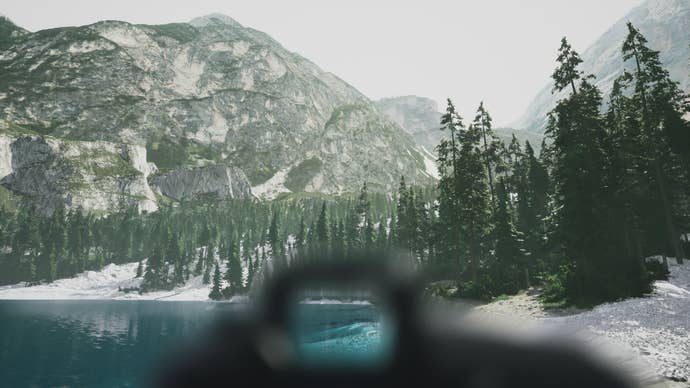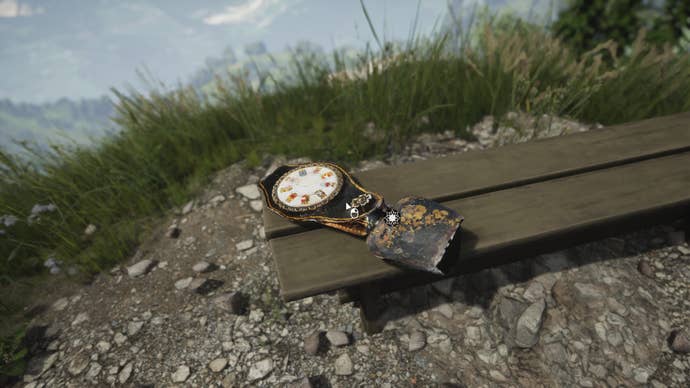Primarily, Lushfoil Photography Sim is – spoilers – a photography sim. Then it’s a walking sim. Then it’s a photography sim again. Then more walking. Then it’s a photography teacher, and a very calm and cool one at that; the kind that would lay down in liquid mud to shoot a daffodil at just the right angle, then get back up and say “Ahhh, that’s lovely” in a gentle New Zealand accent.
This specific quality accounted for much of my initial interest, being someone who owns a DSLR yet has no clue what half the buttons are for. Lushfoil Photography Sim is a pretty effective instructor, though by choosing a series of stonkingly gorgeous natural beauty spots as its classrooms, it’s even more effective at provoking a general wanderlust that has – repeatedly but quite happily – derailed my studies.
You’re free to explore and snap at your own pace, each location dropping you in and setting you loose upon its picturebook-pretty sights. There’s a global mix of locales to work through, starting with a glistening Italian lake and moving onto Japanese Shinto shrines, eerie Icelandic volcanoes, leafy English parkland, and sky-piercing Nepalese mountains. All are densely detailed in spite of their considerable size, and have been sculpted with a literal photographer’s eye – solo developer Matt Newell is a 3D artist and a shutterbug both. If you could throw a rock at one of these maps, you’d hit three things that would make for a nice shot.
Snapping for snapping’s sake, without the learning aspect, is welcomed. With autofocus alone, the default DSLR is more than capable of sweeping landscape shots and macro close-ups alike. If you play Lushfoil Photography Sim by simply wandering around and casually grabbing the occasional pic, there’s never a sense that it’s going to lean over and say: “Well actually that would look better if you switched to aperture priority mode and adjust the f-stop, you tourist.” If anything, staying relaxed is the point. By giving you free run of such beguiling sceneries with naught but some chilled-out background tunes for company, this game quite obviously wants you to appreciate Mother Gaia’s creation as much as it wants you to make PNGs of it.
The ground-level map design encourages exploration too. While you’re mostly confined to pathways rather than granted true free-roamability, they’re constantly splitting off into enticing side-trails, piquing the same “Ooh, what’s down there?” curiosity that all good holidays are filled with. There’s usually something rewarding down these tracks as well, be it a prime shooting opportunity or a new piece of kit to aid your photography efforts. A paddleboard for sea-to-land shots, for instance, or even an inexplicably abandoned camera drone.

A generous fast travel system (you can warp to wherever you’ve previously snapped a photo) helps cut down backtracking along the way, though the sim does well to make its hills, beaches, and forests feel like nice enough places to take a walk in. Besides the visual pizazz (this is Unreal Engine at its most photorealistic, which for once, makes perfect aesthetic sense) it’s one of the most pleasant-sounding games I’ve played in a long while. The instrumental soundtrack is pitch-perfect, all twinkling pianos and soft synths, while details like wind-rustled trees, or how your footsteps snap twigs and compact snow, lock down an already secure sense of place. Each locale may be one big photography subject, but they’re not static backdrops either. Especially when a hare or stray cat darts out from the bushes, usually escaping back into concealment just before you can level a viewfinder at it.
On the subject of camera bits, more enthusiastic photographers will find a sim-appropriate range of granular DSLR controls to tinker with: shutter speeds, ISO levels, white balance, different lenses, all that capturing jazz. But what I appreciate, as an all-the-gear-no-idea photography scrub who usually just snaps graphics cards in Auto mode, is how the game delivers its (entirely optional) lessons in what all those words mean. To the point where I do, genuinely, have a better understanding of my IRL Nikon.

For reasons I can only guess, usability design on DSLRs has never progressed beyond jargon, acronyms, and trying to stuff far too many functions onto far too few switches and dials. Do I want AE-L or AF-L? It’s hard to choose when I have just one button for both, and also I don’t know what either of them are. Lushfoil Photography Sim’s tutorials do what camera manuals never seem to by breaking everything down in simple English, while seizing the natural advantage of being able to map these controls to more intuitive keyboard (or gamepad) inputs. The result is a far more successful teaching tool, at least for me, than any text guide or instructional YouTube video. I’m sure I’ve looked up how to adjust depth of field by changing the aperture size before, but it’s never stuck with me until this game walked me through the fundamentals, with a live, dynamic view of what happens when I make the numbers go up or down.
There are some gaps in its curriculum – I’m still winging it on composition – but for learning the more technical, hardware-adjacent aspects of the craft, I’d recommend this in an instant. As I would for those wanting a breezy, feel-good timekiller that doesn’t try too hard to be trendily “cosy”. In fact, weaknesses only flare up when it acts like, of all things, a video game.
Presumably to engineer some sense of progression, most locations need unlocking before they can be explored, and the means of doing so is strangely out of whack with the rest of the game’s easygoingness. First, you must gather a certain number of collectibles: region-specific items dotted around on benches and plinths. Second, you must find a picture board in each area, observe the photos pinned on it, then go out and take matching ones, in something akin to a (mercifully much easier) version of Elden Ring’s painting puzzles. Only once you’ve acquired enough of both will the next location unlock.

These fetch quests aren’t especially taxing, but they don’t add anything either, outside of an attempt to inject some nakedly game-ish challenge/reward system. The beauty, atmosphere, and branching pathways are more than enough to motivate exploration and phototaking on their own, and at worst it can feel like your picturesque world tour is descending into a treasure hunt that needs completing before you’re allowed the next plane ticket. Besides, part of the fun is having the freedom to frame and shoot your own pictures, and it feels odd that every other player is going to have a partially matching gallery to mine.
The other main unlockables (a variety of older point-and-shoot cameras and camcorders you can find lying around) also failed to conjure up much enthusiasm, given their lack of configurability and low photo quality next to the DSLR. Granted, this is still a photography sim, so I understand why they’re there. I’m sure there are Microsoft Flight Simulator owners with a soft spot for the rattly Cessnas.
I also don’t want it to sound like that bit of collectible busywork spoils what is ultimately a very good mix of satisfying snapping and eyes-agog wandering. You can always just capture the requisite frames while you’re passing by, looking for your own shots, and – truth be told – the striking vistas you’ll win access to are very much worth a spot of picture-matching. Come for the lessons, stay for the landscapes.
This review is based on a retail version provided by the publisher.





